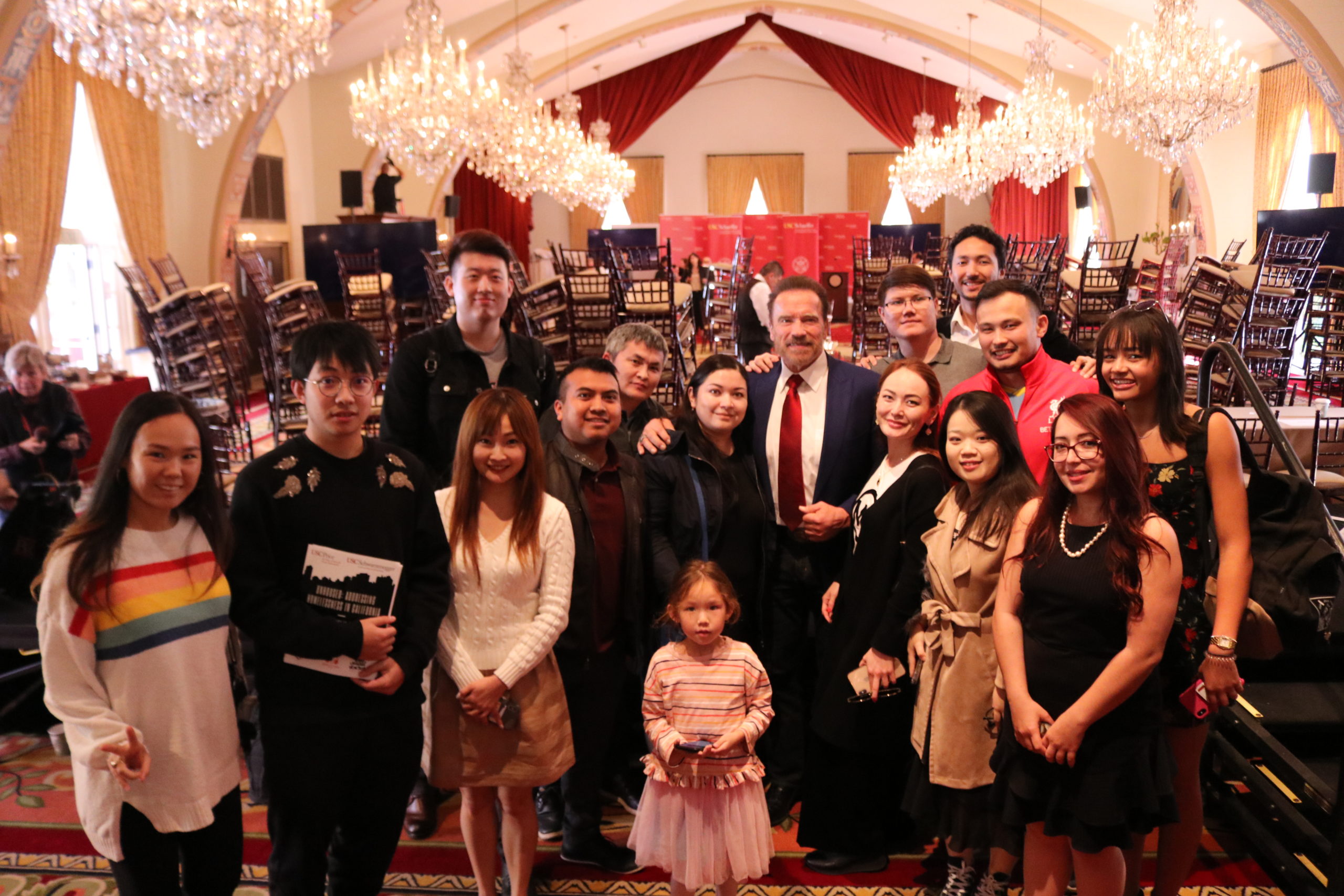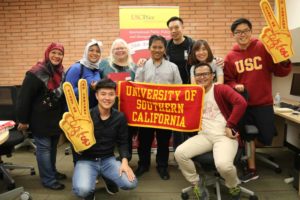By Matthew Kredell
Federal, state and local leaders gathered at USC on Feb. 13 to work together to come up with solutions to address homelessness in California, what former Gov. Arnold Schwarzenegger called a crisis that requires immediate attention.
More than 300 people, including 120 students, attended the homelessness summit that was hosted by the USC Schwarzenegger Institute for State and Global Policy and the USC Sol Price Center for Social Innovation.
In coordination with the summit, the USC Price School and Schwarzenegger Institute released results from a new poll showing that homelessness is viewed as the biggest problem in California by voters, ahead of climate change and immigration.
Acknowledging that the problem can feel too big to solve, Schwarzenegger stressed to remember that behind each statistic cited at the summit is a person.
“We might not want those tents on our sidewalks, but I promise you I don’t think they want to stay in those tents either,” Schwarzenegger said. “They are our neighbors, they are our fellow Californians, and we can do better for them and for all of us. But it will require putting selfishness and partisan bickering aside and sitting down and working together until we find the solution that works.”
USC Price Dean Jack H. Knott noted that the average wage of $23,000 for a low-income worker in Los Angeles is the same as in many other states. However, combined with the average housing cost, Los Angeles is the most expensive and unaffordable city in the country.
“I believe that it’s a moral imperative to protect and house the most vulnerable people in our society, and that universities – in this case USC and the Price School, have a role to play,” Knott said. “Both of these research centers embody the Price School’s evidence-based and collaborative approach to addressing policy issues. They’re uniquely poised to offer research, data and expertise, and work together with policy makers, business leaders and nonprofit leaders to make a difference in society around this issue.”
Former Gov. Gray Davis, Schwarzenegger’s predecessor, proclaimed that it’s time for the state to declare homelessness a public emergency and to not only house but treat the individuals experiencing homelessness. He added that affordable housing projects should get the same expediting of environmental reviews and limits on litigation provided to building stadiums in the state.
“Every day we delay, every day we allow a meritless lawsuit to keep us from housing and treating the homeless, another person dies,” Davis said. “So I want people to leave this meeting today with a sense of urgency and a sense of purpose.”
Former CA state Sen. Kevin Murray, president and CEO of the Weingart Center Association, served as master of ceremonies for the summit.
A federal perspective
U.S. Department of Housing and Urban Development Secretary Ben Carson, in Southern California as part of his “Driving Affordable Housing Across America” bus tour, called for compassion in dealing with homeless individuals.
He outlined some of the federal programs being deployed to help, including $2 billion HUD is awarding to local homelessness-assistance programs.
Carson added that, in a few weeks, HUD will call on every church, synagogue and mosque in America to adopt a person or family experiencing homelessness with the goal of making them self-sufficient in one year.
“We all understand that there is a crisis here, and I think we’re all agreeing that in order to solve that crisis we must be able to look at data, must be willing to look at evidence, and most be willing to throw away ideology and work together,” Carson said. “Recognize that the federal government is willing to do this. We’re willing to look at new programs, we’re willing to emphasize and push new programs, and we hope that everyone here will use their influence to help stamp out NIMBYism, which is behind a lot of our problems.”
Spurred by the bipartisan call to action from Governor Schwarzenegger, Secretary Carson and Los Angeles Mayor Eric Garcetti agreed to form a “working group” to work together to find solutions.
Making progress at the local level
Garcetti noted that, with the passage of two ballot measures in recent years, Los Angeles has an historic amount of resources to fight homelessness.
The city will have 26 bridge shelters open by July, and Measure HHH projects will create about 13,000 new beds for folks in need of supportive housing.
With this focus on addressing homelessness, Garcetti asserted that, despite how bad the problem seems in the city, Los Angeles is close to turning the tide. In the county, housing is being provided to 133 additional people a day compared to 150 people a day who are entering homelessness.
“When you feel overwhelmed by the tents, it’s actually not a big delta,” Garcetti said. “If we have 18 fewer people become homeless every single day or 18 more housed, or some combination of both, we’re on our way down. But my message to our state and federal government is that we can’t do that alone.”
One city that already got over that hump is San Diego. Mayor Kevin Faulconer proudly declared this his was the only major county in the state to lower the number of homeless last year.
Faulconer explained that San Diego stopped making excuses and made a massive adjustment in resources, responsibilities and attitudes. Nurses and paramedics were deployed to every riverbed canyon and street corner to vaccinate more than 100,000 people, bridge shelters were opened, campaigns started to educate the public and sanitize the streets and sidewalks, trash was removed from sidewalks.
“We changed virtually everything, and by doing that we changed lives as a result,” Faulconer said. “… We still have an incredible amount of work to do, but I think one of the reasons we’ve seen this change is because San Diego no longer accepts a sidewalk, riverbed or tarp as a home.”
Research and polling informs homeless issue
Prof. Gary Painter, who serves as director of the USC Price Center for Social Innovation and of the Homelessness Policy Research Institute, provided some statistics on the depth of the homelessness problem and how the state got there.
The number of people experiencing homelessness in California has increased from 120,000 to 150,000 over the past decade. Among this population, 72% are unsheltered. California holds 50% of the nation’s unsheltered population.
While there are multiple reasons that people become homeless, including behavioral issues and health conditions, the majority of people experiencing homelessness cite economic conditions as the primary reason for becoming homeless. Further, polls show that the reasons are exacerbated the longer a person remains homeless.
Painter cited the three root causes of the homelessness crisis as constrained housing supply, severe rent burdens, and institutional and systematic racism. Painter noted the severe overrepresentation of Black individuals experiencing homelessness; while Black individuals make up less than 7% of the state’s general population, they are 29% of the state’s homeless population.
“There’s a ray of hope in this,” Painter said. “We didn’t get here by accident. We got here because we passed policies at the state and local level to actually constrain building. Guess what, it worked. You know what that means? With the right policies, we can undo what we did for ourselves. We crafted policies to stop the building, so we can undo that.”
A recent study by the Downtown Women’s Center, in partnership with the Price Center, showed a 41% increase in the number of women experiencing homelessness. Of homeless women, 60% reported experiencing some form of violence in the last year and 53% reported experiencing domestic violence before becoming homeless.
“In their own words, women have told us what they need in terms of housing, community resources and healthcare, and now it’s on us who hold privileged positions within government, academia and advocacy to align funding, legislation and further research to those needs,” said Amy Turk, CEO of Downtown Women’s Center. “As cities, counties, state and federal officials grapple with different proposals to end homelessness, the voices of these women must be heard.”
Prof. Christian Grose, academic director at the USC Schwarzenegger Institute, provided more results from the new statewide poll of 1,000 likely California voters conducted by USC Price and the Institute.
More than one in four respondents said they personally knew someone experiencing homelessness, and 37.5% said that they were afraid that they or a family member could become homeless.
Respondents appeared conflicted about their compassion to help those experiencing homelessness and their desire to keep homeless encampments out of public areas.
“As Gov. Schwarzenegger said earlier, if you want to take action on homelessness, you need to know what people think,” Grose said. “The best way to get elected officials to take action is to show them what voters of California think on this issue of homelessness.”
State-level access on homelessness
Los Angeles County Supervisor Mark Ridley-Thomas and Sacramento Mayor Darrell Steinberg spoke about some of the 40 suggestions made in the comprehensive crisis response strategy they submitted to Gov. Gavin Newsom as co-chairs of his Homeless and Supportive Housing Advisory Task Force.
Ridley-Thomas noted that the governor already has begun to act on their suggestions, and he expects Newsom to talk more about the efforts during his State of the State address.
He noted that one change the governor already got under way is an executive order that released 100 trailers intended for use with wildfires to provide permanent supportive housing for families that were headed toward homelessness. Within 30 days, 30 of those trailers will be in use in Los Angeles County.
“We need action in real time, no excuses,” Ridley-Thomas said.
Steinberg called for a “Silicon Valley moment” for housing innovations around efficiency. He wants to see smaller units that are less expensive and faster to build.
“This is a failure of imagination, and we aren’t using our public dollars sufficiently to incentivize the creation of this new market,” Steinberg said. “And we must because we will never build enough housing in this conventional way that we know.”
Short-term solutions for addressing homelessness
The real-time impacts of homelessness require quick solutions. State Sen. Holly Mitchell, Long Beach Mayor Robert Garcia, Los Angeles County Supervisor Kathryn Barger and Steinberg participated in a panel on short-term solutions to addressing the problem.
Garcia agreed that there needs to an emergency-level push at the state level to allow the public and private sector to build affordable housing more quickly.
“Unless we loosen up regulations, encourage more building and do a huge statewide emergency plan to build more housing, I don’t believe this issue will be solved any time soon,” Garcia said.
Barger said her focus is on the mental health issue. Los Angeles County is purchasing 500 mental health beds over the next two years with the understanding that the state will enter a waiver with the federal government allowing the county to bill Medicaid for the beds.
Steinberg noted that California substituted fossil fuels with renewable energy because the state mandated it. He contended that a similar mandate is needed with homelessness.
“You know what the mandate did? It changed behavior,” Steinberg said. “It sent a strong signal by the governor that this issue matters and we better change the way we are working and operating.”
He called for the state, in collaboration with local governments, to set aggressive but reasonable benchmarks over aggressive but reasonable periods of time to reduce their unsheltered population and to be held accountable for a failure to make progress toward those imperatives.
Long-term solutions for addressing homelessness
Long-term thinking is always difficult for politicians, as it encompasses planning for a future beyond their terms in office.
But a combination of short-term interventions and long-term planning is needed to get the state out of this cycle.
“I think that we should be spending money now,” Los Angeles Council President Emeritus Herb Wesson said. “It’s important that we do everything that we can quickly. But we have to have a long-range strategy, and I think the most important component of that is to make sure the different government levels eliminate working in silos and that we have to come together and work as one.”
Wesson suggested that it’s cheaper to use low-interest and no-interest loans to keep people in their homes in the first place then to get them back in homes once they’re on the street. He added that there needs to be more creative ways to provide mental health services rather than punishing people who need them.
Assemblymember Miguel Santiago contended that the housing crisis is an opportunity to revisit laws and create a consistent funding stream.
“Local municipalities, nonprofits and the state can’t continue to plan year by year because we’re never going to get into those long-term solutions if we’re only funding for today,” Santiago said. “That’s why we’re going to propose in the next couple of weeks $2 billion from the state as ongoing funding.”






